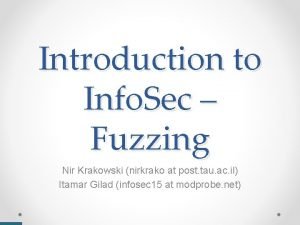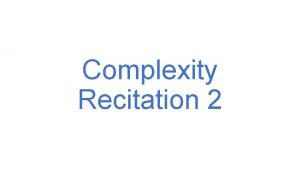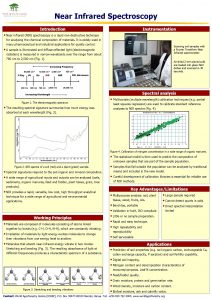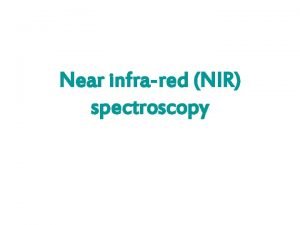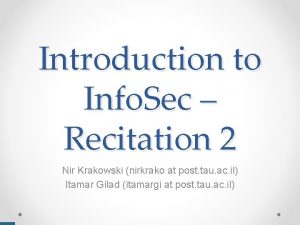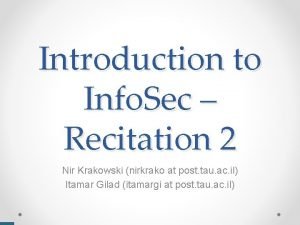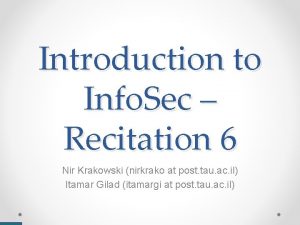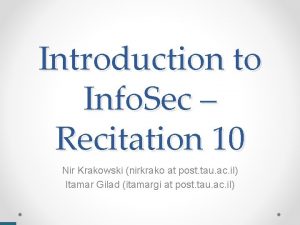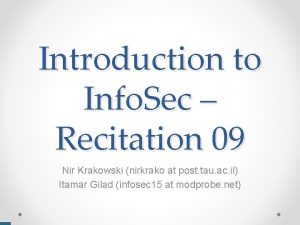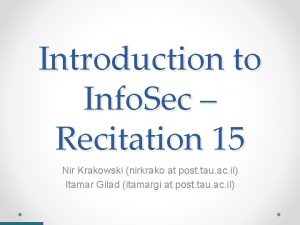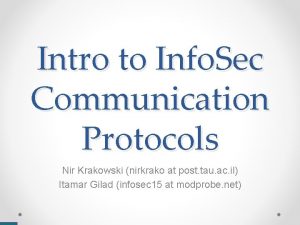Introduction to Info Sec Recitation 13 Nir Krakowski














- Slides: 14

Introduction to Info. Sec – Recitation 13 Nir Krakowski (nirkrako at post. tau. ac. il) Itamar Gilad (itamargi at post. tau. ac. il)

Today • • What is Computer Forensics? Threat types Useful data sources Gathering information Malware Analysis Hunting Rootkits Expanding the search Planning to facilitate forensics and incident analysis

Forensics 101 • We have a suspected machine / network installation • You know little to nothing about the specific threat, and even less about how it got there • You want to know everything! o How they got there o Find and fix any damage they’ve done o Find out if they took any sensitive information o Who they are, what do they want? o Finally – figure out how to prevent the next incident

Threat Types • Non targeted attack – script-kiddies, botnets, driveby downloads, toolbars, scam sites, etc. • Targeted attack, a. k. a. APT (Advanced Persistant Threats) – o They know who you are o They’ll invest lots of resources to get what they want o Very hard to defend against o But if you do your work well – you’ll know what they did

Basic Data Sources • Running process list, loaded Kernel module list • Complete memory image – RAM + Swap • Anything that’s changed in the suspected time frame (time since last major system change is a good start) • Checking file signatures against ‘known good’ list (whitelist) • Contents of config files – users, lowered hardening, anything an attack might want to change • LOG FILES • File / directory creation, modification and access times • Network analysis – which machines download/upload more than they should? Which machines are talking to machines that they shouldn’t?

Gathering Information • You could work in the client’s production environment • But then you could make mistakes that will destroy valuable ‘bread crumbs’ and/or reveal information to the adversary • You want a perfect memory snapshot, and a perfect disk image to take to the lab

Getting a snapshot of the system • Getting the contents of the memory by asking the computer to hibernate / reading memory via Fire. Wire • Getting the contents of the disks by pulling the power immediately, and taking the disks to the lab

Disks or Memory – choose one! • If the attacker was smart – her tools will hide better in a some scenarios o She’s put a hook on the hibernate function, to make the memory snapshot “clean”, and maybe even clean her rootkit from the disk o She might scrub her files off the disk after loading, only writing them back on a regular shutdown, or not at all… • You may have a better tool (Liquid NO 2 + magic) – but you’ll still have to choose one over the other

Malware Analysis • First – a quick check against any known signatures • Then, lots of looking for potential malware • Once good candidates surface, lots of reverse engineering • The goal is to spend as little time initially, to classify things as “interesting”, “maybe”, and “junk” • Finally, start diving into the “interesting” and “maybe” bins • You may find hints that will make you go back on the field and collect more information

Hunting Rootkits • Nir touched upon offline scanning in the last exercise • One of the simplest and most reliable tool to find a rootkit o test any resource via the API o Test again from a trusted machine, booting from a livecd, accessing the data on the lowest level you can muster o Compare the two. Any difference should be worth your time! • Very clever rootkits may detect a process that is walking the entire namespace, and revert to “innocent” operation. Very very rare.

Expanding the Search • You’ve identified a threat • Next step is to build a detector, and spread it as far as you can • Gather more information from new infections you found • Continue to learn more about the attacker • … • Repeat

Planning for Forensics • Instead of reacting – we can plan the system / network to facilitate forensics, and make it much harder for the attacker • Logging should be local AND network based, in multiple locations, and logging servers should be extremely secure • Logging should be as deep as possible (forever is a good depth) • Log anything important, especially anything touching the core secrets of the company • Keep ‘good’ system images for important machines, and again – depth is your friend • Keep an exact and central log for any maintenance event, to help quickly filter these events later on

Monitoring • Find a SOC (Security Operations Center) solution that suits you, and USE it! • Build rules to filter out the noise • Build rules to highlight important events • Central logging will permit high-order anomaly detection, data clustering and machine learning based filtering to help you analyze all that data • If possible – make this system report to the system administrators in real-time! • The key is to actively look for the threats, not just installand-forget…

Questions?
 Itamar gilad
Itamar gilad Active recitation
Active recitation Sajjdah
Sajjdah Is the rote recitation of a memorized written message
Is the rote recitation of a memorized written message Objectives of poem recitation
Objectives of poem recitation Know your material
Know your material What is meant by etiquette of recitation of the holy quran
What is meant by etiquette of recitation of the holy quran Xvvvxv
Xvvvxv Process-oriented learning competencies in role playing
Process-oriented learning competencies in role playing Rcitation
Rcitation Nir shavit
Nir shavit Imr human geography
Imr human geography Nir bitansky
Nir bitansky Nir spectroscopy instrumentation
Nir spectroscopy instrumentation Who is nir
Who is nir
